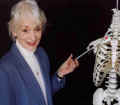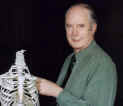 |
 |
 |
Helping You To Achieve ©™

![]()
Helping You To Achieve ©™
|
|
Identify by palpation and surface mark with a pen the Head of the Ulna on a model in the anatomical position with side lighting and a time limit of 10 seconds.
Objective No 10 - Criteria to be demonstrated. 1. Request the model to flex the elbow joint to a right angle and supinate the forearm.2. Take the hand of the model and passively fully flex the Wrist Joint. 3. Fully flex the Elbow Joint and allow the finger tips of the passively flexed wrist joint to touch the shoulder and hold the position,. 4. Observe the medial area of the posterior aspect of the Wrist . 5. A prominent, elevated rounded projection of bone can be observed and palpated. Surface mark this anatomical feature which is the posterior aspect of the Head of Ulna. 6. Immediately lateral to this projecting Head of Ulna is a depression. This depression is the Inferior Radio Ulnar Joint. 7. Place a finger tip on the Head of Ulnar and request the model to supinate and pronate the forearm. Note the changing position of the Ulna and Radius forming the Inferior Radio-ulnar Joint. 8. Place the hand back in the anatomical position and identify by palpation the rounded projection on the medial surface of the lower extremity of the Ulna on the posterior aspect of the wrist area and surface mark with a pen.
|
Service ProvisionBronze. Students may take up a ,'Free start up ' package consisting of 100 of the behavioural objectives and criteria based on common questions asked in Living Anatomy. These are available free of charge on this Website. Silver. Students may buy a copy of the book "Surface and Living Anatomy" (ISBN: 0 7234 3261 9) which comes with a CD Rom (Windows PC format) containing 230 objectives which includes the 100 behavioural objectives contained in the Bronze Service. Gold "Helping you to Achieve" Contact Information
|